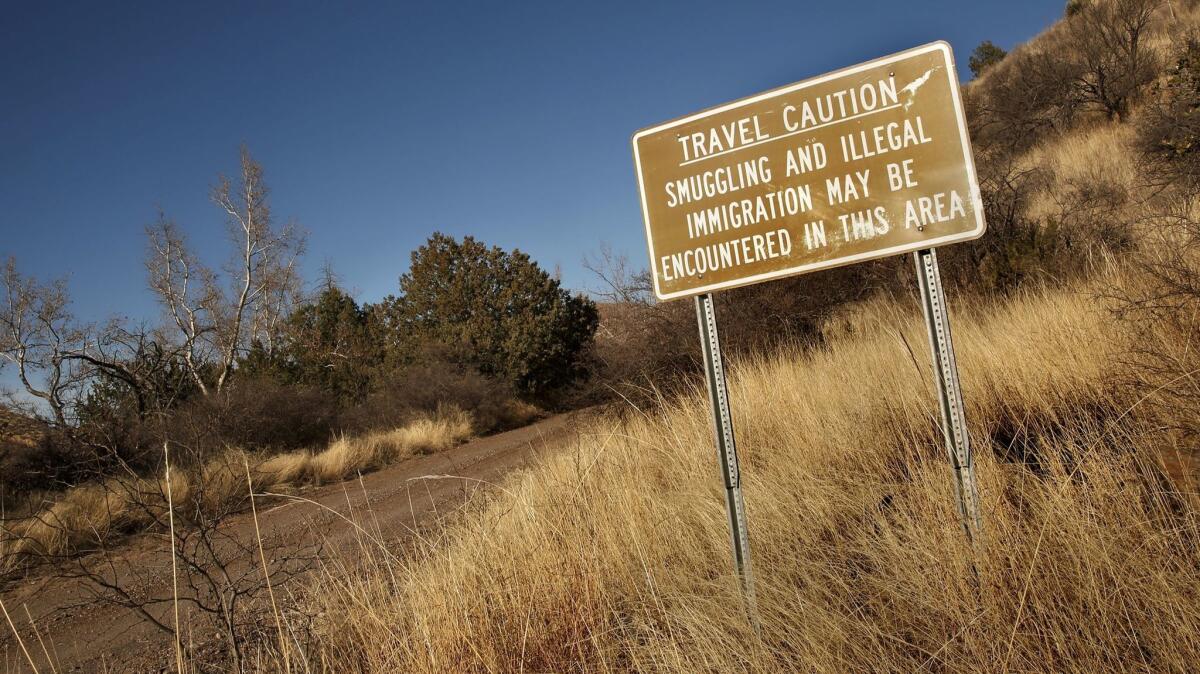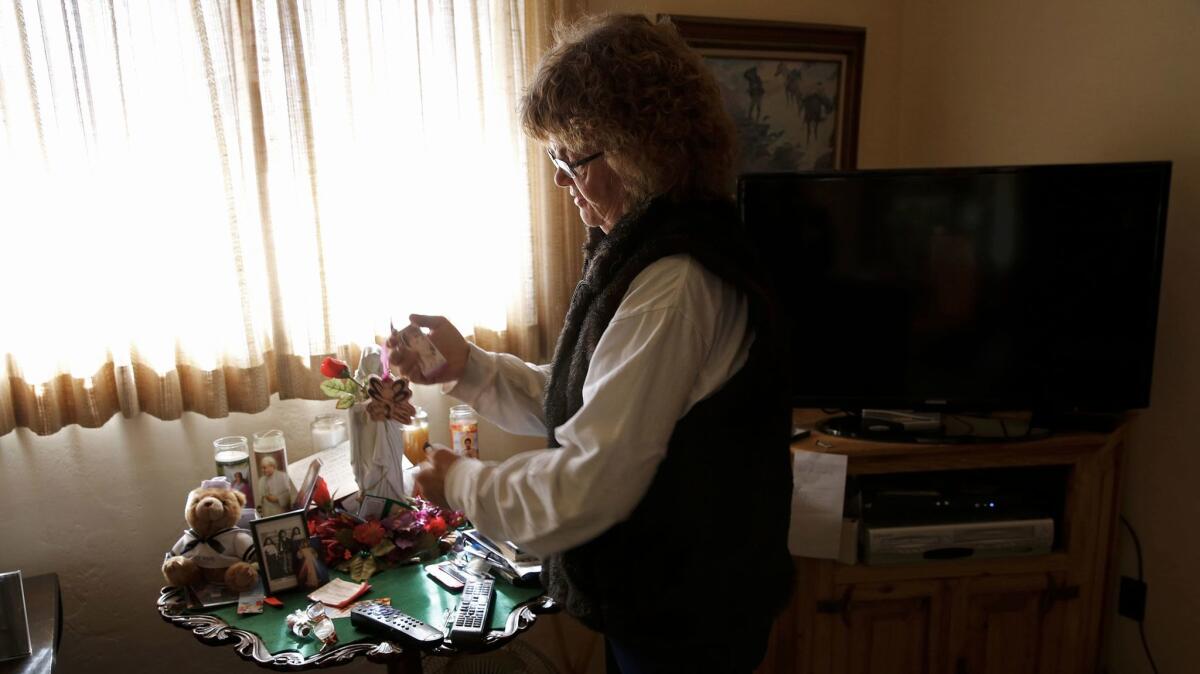Death on the border: Arizona used rancher’s killing to justify harsh immigration laws, but the truth of the case is unclear

The law was passed in 2010 after the unsolved killing of 58-year-old Rob Krentz. Photos by Carolyn Cole of the Los Angeles Times. (June 23, 2017) (Sign up for our free video newsletter here http://bit.ly/2n6VKPR)
Reporting from Douglas, Ariz. — When Sue Krentz was growing up in southern Arizona, about 30 miles from the Mexican border, migrants would wander into the front yard of her parents’ modest ranch house and ask to sweep the steps or mow the lawn.
Nobody asked about their immigration status. It was the 1960s, long before the area became a transit zone for drugs and weapons. Long before farm trucks and cattle started being stolen.
Long before police found her husband slumped in his ATV, shot dead.
No incident has hardened feelings about illegal immigration in Arizona more than the unsolved 2010 killing of 58-year-old Rob Krentz, head of one of the oldest ranch families in southeast Arizona.
It was the impetus less than a month later for the passage of the “show your papers” law, which required police to ascertain the immigration status of anybody suspected of being in the U.S. illegally and helped cement Arizona’s reputation as the country’s toughest state on immigration.
Seven years later, the slaying still resonates, often invoked in local arguments for the massive wall that President Trump has proposed along the border with Mexico.
Usually lost in conversations about Krentz is that it’s far from certain that his killer or killers were in the U.S. illegally. The investigation has identified suspects from both sides of the border.
In recent months, as southern Arizona is again embroiled in the debate over stepped-up border security and stronger measures against illegal immigration, Sue Krentz has reemerged on the public scene, this time as a vocal advocate of an expanded border wall.
“We asked for help, and no one came. We requested a secure border, and were told security was not to be expected. When we asked for safety, we were described as racist,” she complained at a forum on border security last year.
As for her husband’s death, Krentz says that despite the more than 30 people in the U.S. and Mexico identified as persons of interest — including at least one permanent U.S. resident — she has no doubt he was killed by one or more people who stole across the border from Mexico.
“It wasn’t a U.S. resident who shot him,” she said in an interview. “You show me which U.S. resident it was. Give me their name and address. Because there’s nothing down there. There’s not a house for seven miles.”

Krentz’s farm borders an 8-mile-wide corridor between two mountain ranges, the Chiricahuas to the west in Arizona and the Animas to the east in New Mexico. The ranges force pedestrians to stay within a fairly narrow area as they walk north or south, making the territory dicey for migrants seeking to avoid the Border Patrol.
The Krentz family was accustomed to undocumented migrants crossing their 35,000 acres, though the migrants had a habit of cutting ranch water lines instead of walking to a spigot. Each line break allowed thousands of gallons to drain away. Rob Krentz rode out to the site of a break one day on his red Polaris ATV with his dog, a blue heeler.
After back surgery in 2009 and a hip replacement in 2010, Krentz “wasn’t going anywhere fast” on March 27, 2010, Sue Krentz said.
Krentz radioed to his brother, Phil, to say he had spotted a migrant in distress. It was 10 a.m. A nearby rancher heard the same call. Minutes passed, but Krentz’s radio was silent.
Krentz’s son, Frank, tried his cellphone every half-hour. It would ring and then go to voicemail. Neighbors began to walk the property. By 6 p.m., they called the police. When ground searches failed, a police helicopter was called in.
Police found Krentz’s body on a knobby wash six miles east of Arizona Highway 80. His body was cold, but thermal imaging helped locate his dog, Blue, who was shot, shivering and barely alive. Blue would not allow rescuers to reach Krentz’s body, barking and growling whenever someone approached the ATV. The dog was euthanized by an animal control officer.
Krentz had three gunshot wounds: to his left side, upper back and inside his right arm, from 9-millimeter rounds. In his ATV, police found a rifle, still in its scabbard. Police marked as evidence an empty Jimmy Dean sausage case nearby and traced it to a fridge that was raided in a break-in earlier in the week in Portal, Ariz., about 20 miles north of the shooting site.
Footprints in the mud near a water tank showed what police believe to be a man’s stride as he approached it to drink. From there, the footprints led south, toward the ranches on the border.
Another clue came to police over the phone, just days after the shooting:
Caller: Hey, look, I have some information. A man came out; I don’t know if he got into a fight with a dog — I don’t know what.
Dispatcher: What are you calling me about?
Caller: A homicide that took place over there.... These people are apparently the responsible ones.
Dispatcher: OK, but who are they?
Caller: Well, they aren’t from here.... Can you hurry?
The call to the Douglas Police Department cut off after less than two minutes.
The caller said he was in Agua Prieta, Mexico, across the border from Douglas. He said he had seen men who “came out of the desert” with cuts and bruises, and possibly dog bites.
The only hard evidence was a vague outline of a suspect, caught on a U.S. Fish and Wildlife camera, walking south from the shooting site, and a footprint. The suspect had a long stride when walking, and an estimated height of 6 feet.
The investigation slowed to a trickle by early October 2010, six months after the shooting.
Then they found Cachibombo.

Notorious in the area as a suspected drug mule and coyote, Cachibombo’s real name is Horacio Barraza-Parra. He was picked up by the Border Patrol allegedly leading eight people into the U.S. illegally on Oct. 6, 2010. The pollos, or human cargo, in his party told police they were terrified of him.
Barraza-Parra told police he had been in the area near Krentz’s ranch in March 2010, but was stung by a scorpion on the way back to Mexico. He went to Krentz for help. Police confirmed hospital and immigration records showing Barraza-Parra was treated, detained and deported nearly one month before Krentz’s shooting. What happened to him when he returned to Mexico was far more interesting.
Authorities in the U.S. brought in Barraza-Parra’s family for questioning, and learned that after Krentz’s slaying, Mexican drug cartels were just as keen to find the perpetrators.
Members of a cartel kidnapped Barraza-Parra in front of his family and searched his body extensively for evidence of dog bites.
“Sicarios took him for 10 days,” Barraza-Parra’s wife, Alma Pacheco Santos, told U.S. authorities, referring to assassins for the cartels. According to a Cochise County Sheriff’s Office report on the interview, she added: “The [cartels] were upset over all the heat the murder brought to the border.”
Apparently satisfied that her husband was not responsible, she said, the cartel let him go.
For years, occasional “hits” have briefly revived the case — usually computer alerts flagging a Border Patrol detainee as a potential person of interest. They are invariably transported to the Sheriff’s Office, questioned by deputies and Immigration and Customs Enforcement agents, then released back to Border Patrol custody.
Such interviews have turned up suspect after suspect, usually vaguely described as tall men with violent reputations. Some have earned nicknames. “El Grande,” or the Big One; “La Ormiga,” the Ant.
None has yet been linked directly to the slaying. The trail of the tall man appears to have gone cold.
Follow Nigel Duara on Twitter: @nigelduara
ALSO
For five years, she asked ‘Who murdered my daughter?’ Along the way, she found paths to peace
Atty. Gen. Jeff Sessions wants to get tough on crime. These people think he’s got it all wrong
Supreme Court limits the government’s ability to strip citizenship from immigrants
Motorcyclist kicks car and triggers chain-reaction crash in apparent road-rage video
More to Read
Sign up for Essential California
The most important California stories and recommendations in your inbox every morning.
You may occasionally receive promotional content from the Los Angeles Times.











